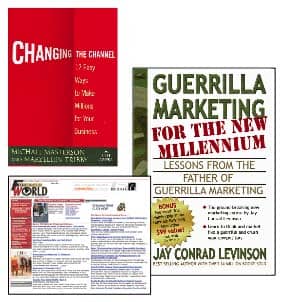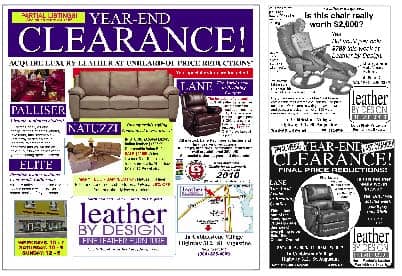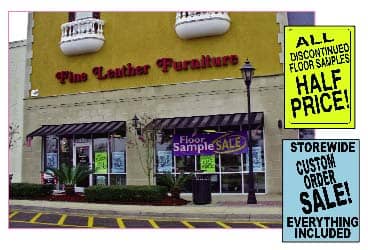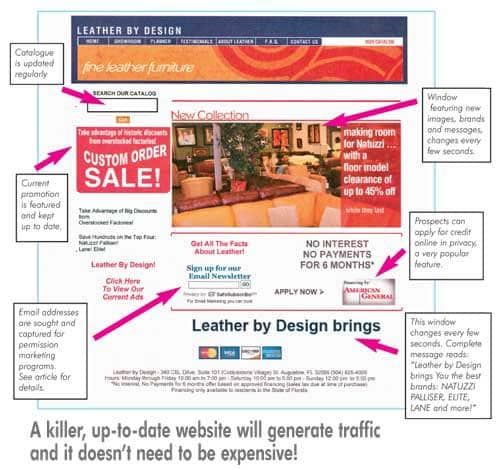How one independent furniture retailer beat the odds in 2008.
Marketing Magic by Larry Mullins
Someone once said that necessity is the mother of invention. In other words, tough times are challenging furniture entrepreneurs to think more, create more, and do better. Furniture customers are difficult to come by and much harder to sell. Media are expensive. So what do you do if you are a small independent with limited resources?

Use downtime to sharpen the saw: “Sharpen the Saw” means to use down time to get better at what you do. Review the Furniture World article archives to read what professionals who work on issues of critical importance to furniture retailers have to say. No one has all the answers, but the collective wisdom of this website is a goldmine. A must-read book for retailers is, “Changing the Channel …12 Easy Ways to Make Millions for Your Business” by Michael Masterson and Maryellen Tribby. In this book you will learn (among other things) the two most important acronyms in marketing today: DRM and MCM … Direct- Response Marketing and Multi-Channel Marketing. In addition to “Changing the Channels”, every CEO should pick up a book titled “Guerrilla Marketing for the New Millennium” by Jay Conrad Levinson. Jay packs a generous amount of useful advice on marketing in about 100 pages.
First of all, if you are an independent with limited cash flow, don’t attempt to copy the furniture companies in your trading area that are big and sluggish. Keep in mind that you can endure lower margins if you can maintain cash flow. Also, if you can find ways to cut your advertising budget, you can still establish an effective presence in the best media.
This article will tell the story of a small leather furniture merchant (3,800 sq. ft.) in St. Augustine who used fresh tactics to beat last year’s numbers in November, December, and January. How he did it is instructive and worth your attention. Prepare to take some notes now and follow up with some improvements. Above all, get moving. The old saying is true: No one can steer a parked car.
Jeff Cohen, owner of Leather by Design and his partner Steve Lent are relatively new to the furniture industry, but they understand marketing, are computer savvy, learn fast, and maintain their poise in this tough home furnishings market. From the greeting to delivery, Leather by Design performs in a passionate, dedicated way: serving the customer and making the experience fun.
Keep on Developing Media Channels
Today independent furniture stores are challenged to use existing media channels more effectively and develop new channels to communicate with prospects. First, let’s talk about how Jeff used the best of the less intrusive media to beat last year’s figures, and began developing new media communication channels to increase market share.
ROP?Newspaper
ROP Newspaper is still cost-effective with older buyers, especially in smaller cities, and most newspapers are cutting good deals (keep in mind that people over 55 control about 75% of the buying power). Newspapers in larger cities are harder to deal with for the smaller independent. The problem is cost and clutter. Getting your ad seen in a large metropolitan paper with a smaller ad or even a flyer requires some tough negotiation and wise planning (although the newspapers are much thinner these days

Leather by Design decided that a custom order event would be a good follow-up to their January clearance. As a traffic-builder, the store announced a half-price discontinued floor sample companion event in the newspaper and used special window signs. These were made inexpensively on colored paper by a local blueprint company. Walk-in traffic from the mall made many new customers aware of the store, and enhanced the selling environment.
Jeff made several great newspaper buys during this turndown and this was key to keeping his numbers up. He picked up a few half-page ads in full color at a reasonable cost, and good placement on the weather page. The local paper also offered him a series of twice-weekly three column x six-inch ads without color for a very reasonable cost. The paper still insisted on a high premium for color, so he went with black and white. Jeff understood that he had to use every inch of this space effectively to sell, not to “brand” or get “name recognition.” He said that the effectiveness of the ads was multiplied because they were all different, yet they were recognized as Leather by Design ads immediately. Check out the exhibits in this article to see how this was done. It was a real challenge to get so much information in such small space.
Effective Copy
Perhaps the most damaging marketing error embraced by furniture merchants is the myth that people do not like to read copy. The fact is that furniture retailers and graphic artists do not like to write copy. People do read copy, especially older customers. This is not a matter of opinion. It is a matter of research and fact. Jeff found that many people came into his store with his ad in their hand. It was not uncommon for them to compliment him for his informative ad. Jeff’s ads contrasted with huge, copy-starved big box ads containing no benefits, no stories, and limited-information approaches.

Leather by Design decided that a custom order event would be a good follow-up to their January clearance. As a traffic-builder, the store announced a half-price discontinued floor sample companion event in the newspaper and used special window signs. These were made inexpensively on colored paper by a local blueprint company. Walk-in traffic from the mall made many new customers aware of the store, and enhanced the selling environment.
There is no doubt that GOBs are having a negative effect on the retail climate. There was a big one going on in St. Augustine during the same period Jeff was striving to do more business. An interesting incident occurred when an older couple shopped Jeff’s store. During a causal conversation with the man while his spouse looked around, the gentleman asked Jeff: “How is business?” Jeff replied: “Not so bad. We are ahead for the year and optimistic about our future.” The man literally leaped to his feet. “I’m so glad to hear something optimistic from a store owner! Good for you!” The message here is obvious: send positive communications to your customers. No one wants to shop with a loser, or leave a custom order deposit with an owner who is dismal about his prospects.
Insert Options
Most newspapers offer insert options. These need not be expensive, full color productions. You can successfully insert a single legal-size page if it is put together with the principles of good advertising. (See “Sharpen the Saw” on page 52.) Use both sides of a single page insert, and insert it on an off-day when you are not competing with the big boxes. If you are running small-space ads, avoid the so-called newspaper “furniture day,” Saturday. This is when there are lots of big competitors’ flyers and ads, and it will be less likely that your ad will be noticed. You want to run your ad when you are the only show in town; and if your ad is well-done and informative, people will save it.
Direct Mail
Direct Mail to existing customers remains the most cost-effective and is a less intrusive medium. It amazes me that I still run into long-time furniture people who don’t have good mailing lists! Jeff began building his list early on last year, uses it, and keeps it current. Your customers want to hear from you. In most communities, and more so in St. Augustine where older customers are still the best home furnishings prospects, although often a tough sell. Timing is critical.
Use personal messages with good stories instead of the look-alike promos used by some large stores. You can hit hard, but gloom and doom stuff that looks slick and packaged is far less effective than an honest, personal message. Custom-prepared direct mail is always best. Post cards work well if they are carefully crafted.
email
Email is becoming a bigger factor. Jeff began gathering email addresses from people who shopped his store and were willing to receive his communications. This is called permission marketing (see David McMahon’s excellent article on this in the January/February 2009 issue of FURNITURE WORLD Magazine). Email addresses are harder to come by, and it takes time to develop this program, but Jeff recently achieved a 3% return from his small list. Email marketing can be virtually free, and can be sent out with special software or using a service like Constant Contact in a few seconds. The important thing is to keep email communication open, but not to always try to sell something. Free information is always welcome. Give tips about your products, offer a free premium just for dropping in, or ask how their purchase is working out.

Website Maintenance
One of the most costly blunders furniture retailers make is not keeping their website current, vibrant and alive. Too many small stores put up a website and never look at it again. It becomes out-of-date, stale, and even negative. Even larger stores fail to monitor their websites as they should. This is the responsibility of the CEO.
He or she can delegate it, but care should be taken to make sure it is relevant and rich with current information. Adding Google Analytics can help in this effort. See Leslie Carother’s article on this powerful tool in the May/June 2008 issue of FURNITURE WORLD (posted to the article archives on furninfo.com). Jeff posted a graphic that announced each event in turn; first his end-of-year clearance and then his custom order sale and floor sample blowout. He also posted every ad, so prospects could look them over. On his website, he has a page for floor sample discounts. He shows a weekly feature at a killer price. The story is, “Come see many other discontinued floor sample bargains, there is often something new.” Each ad featured a line to visit his website, creating a synergy effect.
Signs and Point of Purchase are silent salespersons and should be coordinated with the event. Note the exhibits in this article, and see how Jeff continued his message on his sales tags. Jeff also posted his current advertisements on the front door at eye level. I should address the issue of pricing. Always use a comparative retail value for your up-price, and only have one tag on your goods at a time.
The comparative should be reasonably calculated. “Everyday Low Price” may work for some higher end stores, but it is definitely not for promotional stores during recession times. Negotiation demands by prospects will quickly kick-in; and if your salespeople start negotiating too quickly, the price will lose its integrity. Also, if you are working on tight margins or cutting margins, if you fail to state a credible comparable value on your tag you will not get credit for the value you are offering.
Jeff used two kinds of window signs during his event. He used colored paper and coordinated them with his price tags. Because a custom-order event relies upon a higher-end customer, Jeff had a companion event “All Discontinued Floor Samples ? Price!” This increased traffic and led to a step-off into regular stock merchandise. Window signs and floor sample tags made the double event visible to mall traffic. He posted the current ads at eye-level on the front door.
Jeff’s local radio options are fairly costly and cluttered, and were not used.
DRM & MCM
Jeff is aware that he needs to increase his marketing channels to reach more people and increase sales. An excellent primer on this subject is a book, “Changing the Channel …12 Easy Ways to Make Millions for Your Business” by Michael Masterson and Maryellen Tribby. In this book you will learn (among other things) the two most important acronyms in marketing today: DRM and MCM … Direct- Response Marketing and Multi-Channel Marketing. These are so important that I will address an article to them exclusively. Briefly, DRM is marketing that opens customers’ wallets; it is informational, highly targeted, and of explicit interest or intent. This is a different approach than “branding,” which is image-building, has broad reach and no conscious intent. I believe in branding, but now is the time to focus on stimulating direct-response from advertising. MCM (Multi-Channel Marketing) offers customers more than one way to learn about you and make a purchase. More on these in a later issue.
I should also mention two concepts discussed at length previously: Decorator seminars and Shop-at-Home services. Jeff plans to work on these in the immediate future.
Sharpen The Saw
“Sharpen the Saw” means to use down time to get better and better at what you do. Review the Furniture World (www.furninfo.com) archives, especially current articles by myself and the other professionals who work on these issues. No one has all the answers, but the collective wisdom of this website is a goldmine; the best source of information in the furniture industry today.
Jeff’s great strength is that he is constantly striving to improve his marketing skills. This includes one-on-one encounters, a process I call “People Media.” For example, he was concerned about customers who might protest when an item is put on sale after they bought it a week before. My suggestion may be counterintuitive to some: Always jump at the chance to cheerfully refund a customer’s money in this situation (up to 30 days or so, is a reasonable time period). This led to a remarkable episode concerning Jeff and a prospective customer. A lady who had been looking at a pair of leather occasional chairs happened to drop in to his store and say she had decided to buy. In the spirit of the philosophy above, Jeff told her he was launching a custom order event, and if she waited just a few days he could save her $100. The woman looked incredulous, blinked, and grabbed Jeff in a bear hug! She thanked him profusely. When Jeff told me about the incident I said: “You just bought yourself $10,000 worth of word-of-mouth advertising for $100.” Believe me, this is true.
In addition to “Changing the Channels”, every CEO should pick up a book titled, “Guerrilla Marketing for the New Millennium” by Jay Conrad Levinson. If you don’t have a trusted consultant you must take the time to learn the critical things you need to know. Jay packs a generous amount of useful advice on marketing in about 100 pages. His ideas are right on target, and he is applying the new principles of DRM and MCM as effectively as any pro in the business. He understands the value of powerful copy, and is a master at applying it to new media concepts and channels. Be sure someone on your staff is trained to write killer copy, do creative ads and direct mail, and keep up with the rapidly changing advertising techniques, especially in cyberspace. Do this and you will be poised to prosper when the turn-around begins. And, there will be fewer competitors around to struggle with for the rising tide of new prospects.
We work in an exciting industry, dedicated to making homes more beautiful and comfortable. Keep in mind that furniture is one of the very best values in the consumer spectrum. Home furnishings are more practical and important to the welfare of the family than a new boat or a new giant screen TV. You are doing customers a service when you keep them informed about your great store, helpful personnel, and good values.
Larry Mullins has 30+ years experience on the front lines of furniture marketing. Larry’s mainstream executive experience, his creative work with promotion specialists, and mastery of advertising principles has established him as one of the foremost experts in furniture marketing. His turnkey High-Impact programs produce legendary results for everything from cash raising events to profitable exit strategies. His book, IMMATURE PEOPLE WITH POWER … How to Handle Them will be released by Morgan James Publishing later this year. Joe Girard, “The World’s Greatest Salesman” said of this book: “If I had read Larry Mullins’ book when I started out, I would have reached the top much sooner.”
Larry is founder and CEO of UltraSales, Inc.. Email questions to him at larrym@furninfo.com and see many more articles by Larry on the www.furninfo.com website